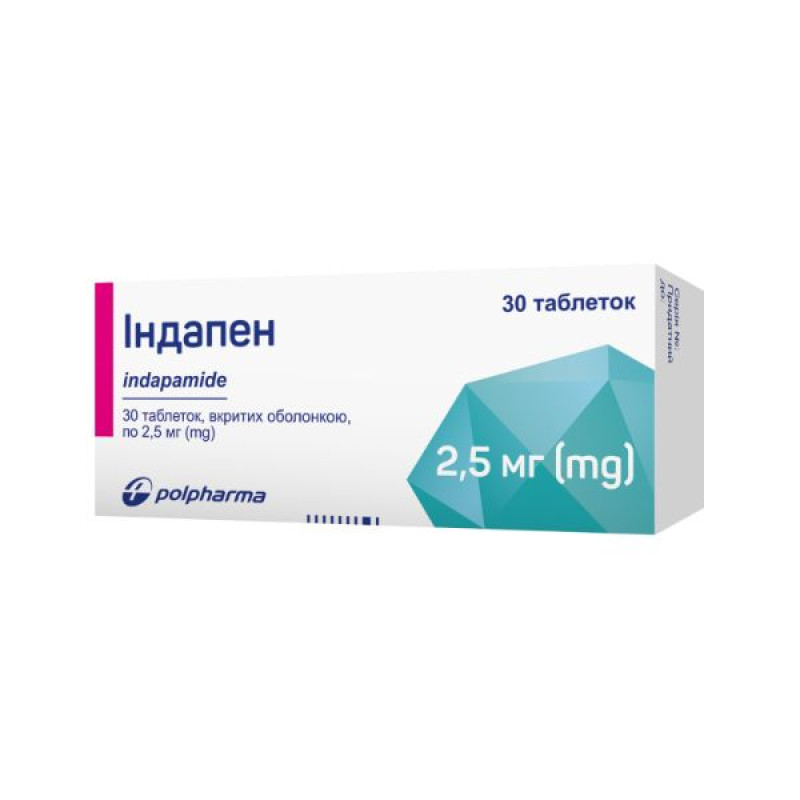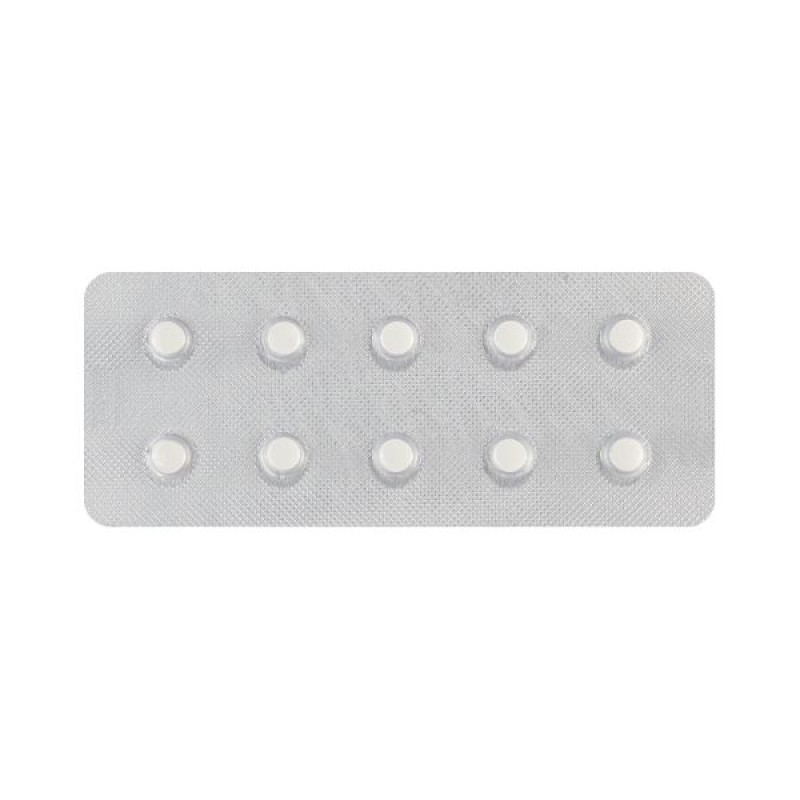Indapen film-coated tablets 2.5 mg blister No. 30

Instructions Indapen film-coated tablets 2.5 mg blister No. 30
Composition
active ingredient: indapamide;
1 film-coated tablet contains 2.5 mg of indapamide;
excipients: microcrystalline cellulose, crospovidone, magnesium stearate;
shell: microcrystalline cellulose, hypromellose, stearic acid, titanium dioxide (E 171).
Dosage form
Film-coated tablets.
Main physicochemical properties: white, round, biconvex tablets with a rough surface.
Pharmacotherapeutic group
Non-thiazide diuretics with moderate diuretic activity. Sulfonamides, simple preparations. Indapamide.
ATX code C03B A11.
Pharmacological properties
Pharmacodynamics
Indapamide is a sulfonamide diuretic that is pharmacologically related to thiazide diuretics. Indapamide inhibits sodium reabsorption in the cortical segment of the kidney. This increases the urinary excretion of sodium and chloride and, to a lesser extent, the excretion of potassium and magnesium, thereby increasing diuresis. The antihypertensive effect of indapamide is manifested at doses at which the diuretic effect is insignificant. Moreover, its antihypertensive effect is maintained even in hypertensive patients undergoing hemodialysis.
Indapamide has high lyophilicity and acts at the level of the vascular wall, namely:
– changes the transmembrane flow of ions (primarily calcium), which leads to a decrease in the contractile ability of smooth muscles in blood vessels; stimulates the synthesis of prostaglandin PGE2 and prostacyclin PGI2, which is a vasodilator and inhibitor of platelet aggregation). All this leads to a decrease in the total resistance of peripheral vessels and arterioles and causes a decrease in blood pressure.
Indapamide reduces left ventricular hypertrophy.
In short-term, medium-term and long-term follow-up of patients with arterial hypertension, indapamide has been shown to:
– does not affect the metabolism of lipids: triglycerides, LDL cholesterol and HDL cholesterol;
– does not affect carbohydrate metabolism, even in patients with arterial hypertension on the background of diabetes mellitus.
Pharmacokinetics
After oral administration, indapamide is rapidly and completely absorbed, reaching peak blood concentrations after 1-2 hours. Indapamide accumulates in erythrocytes and is 71-79% bound to plasma proteins and erythrocytes. The elimination half-life (t0.5) is approximately 15 hours. Steady-state is reached after 4 days. Due to its high lipid solubility, the drug penetrates through the walls of vascular smooth muscle fibers.
Renal clearance accounts for 60-80% of total clearance. Most of indapamide is metabolized, 5-7% of the substance is found in the urine in unchanged form. 20-30% of the administered dose is excreted in the feces.
Indication
Arterial hypertension.
Contraindication
Hypersensitivity to indapamide, to any of the other ingredients of the drug or to other sulfonamides. Severe renal failure. Hepatic encephalopathy and severe liver dysfunction. Hypokalemia.
Interaction with other medicinal products and other types of interactions
Not recommended combinations:
Lithium: Increased plasma lithium levels and symptoms of overdose may occur due to decreased lithium excretion (as with a salt-free diet). If diuretic therapy is necessary, careful monitoring of plasma lithium levels and dose adjustment are necessary.
Combinations requiring caution:
Drugs that can cause torsades de pointes (paroxysmal ventricular tachycardia of the "pirouette" type):
- class Ia antiarrhythmic drugs (quinidine, hydroquinidine, disopyramide)
- class III antiarrhythmic drugs (amiodarone, sotalol, dofetilide, ibutilide)
- some antipsychotic drugs:
· phenothiazines (chlorpromazine, cyamemazine, levomepromazine, thioridazine, trifluoperazine);
· benzamides (amylsulpride, sulpiride, sultopride, tiapride)
· butyrophenones (droperidol, haloperidol)
- other medicines: bepridil, cisapride, diphemanil, intravenous erythromycin, halofantrine, mizolastine, pentamidine, sparfloxacin, moxifloxacin, intravenous vincamine.
Before prescribing such a combination, check the potassium level and, if necessary, correct it. The patient's clinical condition, plasma electrolytes and ECG should be monitored. In the presence of hypokalemia, drugs that do not cause torsades de pointes should be prescribed.
Nonsteroidal anti-inflammatory drugs (for systemic use), including selective COX-2 inhibitors, high doses of salicylates (more than 3 g/day):
- may reduce the hypotensive effect of indapamide;
ACE inhibitors. Sudden hypotension and/or acute renal failure may occur in patients with hyponatraemia (especially in patients with renal artery stenosis). In hypertensive patients in whom previous diuretic therapy has resulted in hyponatraemia, the diuretic should be discontinued for three days before starting treatment with an ACE inhibitor and then, if necessary, the diuretic should be reinstituted, or the ACE inhibitor should be started at a low initial dose and titrated gradually. In patients with congestive heart failure, the ACE inhibitor should be started at a low dose, possibly after reducing the dose of the concomitant potassium-sparing diuretic. In any case, renal function (plasma creatinine) should be monitored during the first two weeks of treatment with an ACE inhibitor.
Drugs that may cause hypokalemia when administered concomitantly: gluco- and mineralocorticoids (systemic), amphotericin B (intravenous), tetracosactide, laxatives that stimulate peristalsis: increase the risk of hypokalemia (additive effect). Plasma potassium should be monitored and corrected if necessary, special attention should be paid to concomitant therapy with cardiac glycosides. It is recommended to prescribe laxatives that do not stimulate peristalsis.
Cardiac glycosides: the presence of hypokalemia increases the toxicity of cardiac glycosides. Plasma potassium and ECG monitoring should be performed and therapy adjusted if necessary.
Baclofen enhances the antihypertensive effect of the drug. At the beginning of therapy, it is necessary to restore the patient's water and electrolyte balance and monitor kidney function.
Combinations that require attention:
Potassium-sparing diuretics (amiloride, spironolactone, triamterene):
This combination does not exclude the possibility of hypokalemia, especially in patients with diabetes mellitus or renal insufficiency, or hyperkalemia. Monitoring of potassium in the blood plasma, ECG monitoring and, if necessary, adjustment of therapy should be carried out.
Metformin: The risk of lactic acidosis is increased in patients with functional renal insufficiency due to diuretics, especially loop diuretics. Metformin should not be prescribed if the blood creatinine level exceeds 15 mg/L (135 μmol/L) in men and 12 mg/L (110 μmol/L) in women.
Iodine contrast media: In case of dehydration caused by diuretics, the risk of acute renal failure increases, especially when using large doses of iodinated contrast media. It is necessary to restore water balance before administering iodinated contrast media.
Imipramine-like antidepressants, neuroleptics: increased risk of orthostatic hypotension (additive effect).
Calcium salts: hypercalcemia may occur due to decreased renal calcium elimination.
Cyclosporine, tacrolimus: plasma creatinine may increase without affecting circulating cyclosporine levels, even in the absence of water and sodium depletion.
Corticosteroids, tetracosactide (systemic): reduction of the hypotensive effect of indapamide due to water and sodium retention under the influence of corticosteroids.
When using indapamide with the above-mentioned drugs, the risk of ventricular arrhythmias increases, in particular torsades de pointes - paroxysmal ventricular tachycardia of the "pirouette" type (hypokalemia is a risk factor).
Application features
In patients with impaired liver function, the use of thiazide-like diuretics may lead to the development of hepatic encephalopathy. In such cases, indapamide should be discontinued immediately.
Photosensitivity: Photosensitivity reactions have been reported in patients receiving thiazide and thiazide-like diuretics. If such reactions occur, diuretic therapy should be discontinued. If diuretic therapy is re-introduced, it is recommended that exposed areas be protected from sunlight or artificial ultraviolet light sources.
Water and electrolyte balance:
Plasma sodium level
Measured before starting treatment and regularly thereafter. Treatment with any diuretic may cause hyponatremia, sometimes with very serious consequences. A decrease in plasma sodium levels may initially be asymptomatic, so regular monitoring is recommended; in elderly patients and patients with cirrhosis of the liver, sodium levels should be measured more frequently.
Plasma potassium level
Patients with prolonged QT interval are also at risk, whether congenital or iatrogenic. In this case, hypokalemia, like bradycardia, is a factor contributing to the development of severe arrhythmias, including potentially fatal torsades de pointes. In all of the above cases, more frequent measurement of plasma potassium is recommended. The first measurement of plasma potassium should be performed within the first week of treatment. If hypokalemia is detected, it should be corrected.
Plasma calcium level
Thiazide and thiazide-like diuretics may reduce urinary calcium excretion and cause a slight transient increase in plasma calcium levels. Overt hypercalcemia may be due to previously unrecognized hyperparathyroidism. Treatment should be discontinued prior to evaluation of parathyroid function.
Blood glucose level
In patients with diabetes, especially in the presence of hypokalemia, it is necessary to monitor blood glucose levels.
Uric acid
In patients with hyperuricemia, the frequency of gout attacks may increase.
Kidney function and diuretics
Thiazide and thiazide-like diuretics are effective only in cases of normal or minimally impaired renal function (plasma creatinine level below 25 mg/L, i.e. 220 μmol/L in an adult). In elderly patients, plasma creatinine levels should be appropriate for age, weight, and sex.
Secondary hypovolemia due to water and sodium loss under the influence of diuretics at the initial stage of treatment may cause a decrease in glomerular filtration rate. This may lead to an increase in blood urea and plasma creatinine. In normal renal function, temporary functional renal failure is of no clinical significance, but may aggravate existing renal failure.
Athletes
The use of the drug may cause a positive reaction during doping control.
If the recommended dose is exceeded, the therapeutic effect does not increase, but the number of undesirable effects increases. If the treatment is not effective enough, increasing the dose is not recommended.
The drug contains lactose, so patients with rare hereditary diseases such as galactose intolerance, Lapp lactase deficiency or glucose-galactose malabsorption should not take this drug.
Use during pregnancy or breastfeeding
Pregnancy
Diuretics should generally be avoided in pregnant women. Diuretics should not be used to treat physiological edema in pregnant women because they may cause fetoplacental ischemia with the risk of fetal growth restriction.
Breast-feeding
Indapamide passes into breast milk, so breastfeeding is not recommended while taking the drug.
Ability to influence reaction speed when driving vehicles or other mechanisms
During the use of the drug, in some cases, various reactions associated with a decrease in blood pressure may occur, especially at the beginning of treatment or in case of combination with another antihypertensive agent. As a result, the ability to drive or operate other mechanisms may be impaired.
Method of administration and doses
For oral use: one tablet (2.5 mg) per day, preferably in the morning. The tablet should be swallowed whole, without chewing, with water. The tablet should not be divided.
The use of higher doses of the drug does not lead to an increase in the antihypertensive effect, but the diuretic effect increases.
The duration of treatment depends on the course of the disease and the response to treatment.
Patients from risk groups – see section “Special instructions for use”.
Children
Indapen is not recommended for use in the treatment of children and adolescents due to insufficient data on safety and efficacy in this patient group.
Overdose
The toxic effect of indapamide at doses up to 40 mg has not been confirmed.
Signs of acute poisoning include water and electrolyte disturbances such as hyponatremia and hypokalemia. Overdose with indapamide may be accompanied by nausea, vomiting, hypotension, convulsions, dizziness, drowsiness, confusion, polyuria or oliguria, which may progress to anuria caused by hypovolemia.
Initial measures include rapid elimination of ingested substances by gastric lavage and/or administration of activated charcoal, followed by restoration of fluid and electrolyte balance.
Adverse reactions
Most of the undesirable effects, both clinical and laboratory, are dose-dependent. Thiazide-like diuretics, including indapamide, may cause the undesirable effects listed below.
From the blood and lymphatic system: thrombocytopenia, leukopenia, agranulocytosis, aplastic anemia, hemolytic anemia.
From the nervous system: dizziness, fatigue, headache, paresthesia, vertigo, muscle cramps, fainting.
Cardiovascular system disorders: arrhythmia, hypotension, torsades de pointes, which can be fatal, prolongation of the QT interval on the electrocardiogram.
Renal and urinary disorders: renal failure.
On the part of the hepatobiliary system: impaired liver function, in the presence of liver failure, hepatic encephalopathy, hepatitis may occur.
Skin and subcutaneous tissue disorders: Hypersensitivity reactions, mainly of the skin, in patients predisposed to allergic and asthmatic reactions: macropapular rash, purpura, angioedema and/or urticaria, toxic skin necrolysis, Stevens-Johnson syndrome. Exacerbation of existing systemic lupus erythematosus is possible. Cases of photosensitivity reactions have been reported.
Laboratory indicators
Hypokalemia: In clinical trials conducted with indapamide 2.5 mg, some patients experienced a decrease in serum potassium after 4-6 weeks of treatment: 10% of patients had a potassium level below 3.4 mmol/l and 4% of patients had a potassium level below 3.2 mmol/l. The mean decrease in serum potassium was 0.23 mmol/l after 12 weeks of treatment.
Hypercalcemia.
Hyponatremia with hypovolemia can lead to dehydration and orthostatic hypotension. The concomitant loss of chloride ions can cause secondary compensatory metabolic alkalosis.
During treatment with thiazide diuretics, an increase in uric acid and glucose levels in blood plasma is possible: the rationality of prescribing these diuretics should be carefully weighed before prescribing to patients with gout and diabetes mellitus; increased liver enzymes.
Potassium loss with hypokalemia of particularly severe severity has been observed in high-risk patients.
Expiration date
3 years.
Storage conditions
Store at a temperature not exceeding 25 °C in the original packaging.
Keep out of reach of children.
Packaging
10 tablets in a blister; 2 or 3 or 6 blisters in a cardboard box.
Vacation category
According to the recipe.
Producer
Pharmaceutical Plant "Polpharma" S. A., Poland/
Pharmaceutical Works "Polpharma" SA, Poland.
Location of the manufacturer and its business address
19 Pelplinski Street, 83-200, Starogard Gdański, Poland/
19, Pelplinska Str., 83-200 Starogard Gdanski, Poland.
There are no reviews for this product.
There are no reviews for this product, be the first to leave your review.
No questions about this product, be the first and ask your question.










